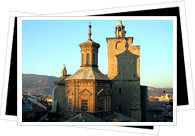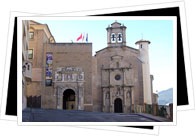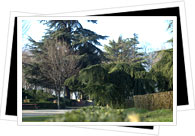Highlights:
Once you've visited La Navarrería, continue your city tour through the boroughs of San Cernin and then San Nicolás before heading to La Ciudadela, located in the southern portion of the city.
Iglesia de San Cernin Start off at the Iglesia de San Cernin (Church of San Cernin), situated just a few meters southwest of the Ayuntamiento (City Hall). Built in the 12th and 13th centuries, the Iglesia de San Cernin served as the borough's principal place of worship; however, that wasn't its only function. At the time, the three boroughs were rival municipalities, constantly engaging in attempts to destroy each other. For this very reason, the church - with thick, strong walls, small windows and lookout towers - was constructed to serve as a defensive fortress as well.
Start off at the Iglesia de San Cernin (Church of San Cernin), situated just a few meters southwest of the Ayuntamiento (City Hall). Built in the 12th and 13th centuries, the Iglesia de San Cernin served as the borough's principal place of worship; however, that wasn't its only function. At the time, the three boroughs were rival municipalities, constantly engaging in attempts to destroy each other. For this very reason, the church - with thick, strong walls, small windows and lookout towers - was constructed to serve as a defensive fortress as well.
The church, a single-naved construction with a polygonal apse, is brimming with flawlessly preserved Gothic features, including pointed arches and vaults, an austere and sober atmosphere, pretty chapels wedged between the buttresses and a magnificent 13th century doorway. The view of the illuminated church and tower at night is one of the most emblematic views of the city- don't miss it!
Cámara de los Comptos RealesLocated on Calle Ansoleaga and just a few steps from the Iglesia de San Cernin is the Cámara de los Comptos Reales. The former palace was built in the 13th century and since the early 16th century has been the home of Navarra's treasury, where royal finances were historically controlled.
The Cámara de los Comptos Reales, a beautiful yet austere palace with pointed arches typical of the style, is Pamplona's only surviving example of civil Gothic architecture. One of the most delightful parts of the building is the gardened courtyard, where you can find an ancient well, archaeological pieces from the former Ermita de San Nicolás Sangüesa (Chapel of San Nicolás Sangüesa), and a Latin inscription in the spot where an injured Saint Ignatius Loyola fell all the way back in 1521.
Museo de Navarra From the Cámara de los Comptos Reales, pass back across the Iglesia de San Cernin, through the Plaza del Ayuntamiento and up Calle Santo Domingo to the Museo de Navarra, an interesting little art and archaeology museum housed in an impressive building that once held the city hospital.
From the Cámara de los Comptos Reales, pass back across the Iglesia de San Cernin, through the Plaza del Ayuntamiento and up Calle Santo Domingo to the Museo de Navarra, an interesting little art and archaeology museum housed in an impressive building that once held the city hospital.
Once you've had your fill of artistic masterpieces and archaeological relics, continue southwest along the edge of the city and you'll pass a handful of religious buildings- the 17th century convent Convento de las Carmelitas Descalzas, the Basílica de la Virgen de la O, and the Convento de las Agustinas Recoletas, a convent founded in 1624 and still in operation today. Opposite the Convento de las Agustinas Recoletas and across the similarly named Plaza de Recoletas is is yet another church, the Iglesia de San Lorenzo. Only the tower remains of the original 13th century church of San Lorenzo, the rest being a much newer structure. However, this church is where you'll find the famous chapel of San Fermín.
Parque de la Taconera Behind the Convento de las Agustinas Recoletas is Pamplona's beloved Parque de la Taconera, the oldest park in the city and certainly in the running to be the prettiest. Built in 1830, this romantic French-style park boasts ancient and exotic trees and flowers, walking paths, fountains, monuments - such as the one dedicated to local opera legend Julián Gayarre - and a popular café, Café Vienés, for all your coffee and tea needs. Enjoy the viewpoints over the river, the city and the mountains beyond, and be sure to check out the small "zoo", where deer, peacocks, swans, ducks, rabbits and other animals roam about in semi-freedom.
Behind the Convento de las Agustinas Recoletas is Pamplona's beloved Parque de la Taconera, the oldest park in the city and certainly in the running to be the prettiest. Built in 1830, this romantic French-style park boasts ancient and exotic trees and flowers, walking paths, fountains, monuments - such as the one dedicated to local opera legend Julián Gayarre - and a popular café, Café Vienés, for all your coffee and tea needs. Enjoy the viewpoints over the river, the city and the mountains beyond, and be sure to check out the small "zoo", where deer, peacocks, swans, ducks, rabbits and other animals roam about in semi-freedom.
From La Taconera, pass from the borough of San Cernin into that of San Nicolás via Calle Taconera and take a left onto Calle Nueva, the street that marks where the defensive wall that once separated San Cernin and San Nicolás stood. Take your first right and in just a minute or two you'll come across the 13th century Iglesia de San Nicolás, the main church of the borough of San Nicolás. Like the church of San Cernin, the Iglesia de San Nicolás was constructed both as a church and as a defensive structure. In fact, while only one remains today, the church was actually built with three watchtowers.
You completely forget its fortified exterior once you get a glimpse of the beautiful Gothic temple within. Laid out in the shape of a Latin cross, the church has three naves, an incredible Baroque organ, pointed vaults and arches and impressive stained glass windows which were added in the 14th century.
Paseo Sarasate & Monumento a los FuerosFrom the Iglesia de San Nicolás, cross the street Calle de Pablo Sarasate to the Paseo de Sarasate. This tree-lined promenade, with the old Palacio de Justicia (Palace of Justice / courts) on one end and the Palacio de Navarra (Palace of Navarra) on the other, is a favorite spot amongst locals to go for a stroll. Along the way, enjoy the sculptures of Spanish kings added in the 19th century in an effort to make the promenade prettier.
At the end of the Paseo de Sarasate and across from the Palacio de Navarra, headquarters of hte regional government, is the emblematic Monumento a los Fueros. This towering monument, adorned with allegorical sculptures, is the symbol of the lasting self-government of Navarra. In 1893, the Spanish crown attempted to take away the historical privileges of the Old Kingdom of Navarra; the fiercely independent Navarrans, however, made a stand and the Spanish monarchy eventually stepped down. Ten years later, this monument was constructed out of public donations.